15 Strange Foods You’d Only Eat At A Church Potluck Back In The ’60s And ’70s

Church potlucks in the ’60s and ’70s were more than just meals—they were full-blown events, blending community, creativity, and a hefty dose of culinary curiosity.
Long before Pinterest recipes and gourmet trends, these gatherings were where home cooks flexed their flair for the unusual. The dishes brought to the table were often colorful, sometimes questionable, but always made with love.
From Jell-O molds packed with everything from olives to canned tuna, to mayonnaise-heavy “salads” that barely resembled anything green, potluck tables were a smorgasbord of oddities and local favorites. These recipes may raise eyebrows today, but they were once staples—proudly served and often devoured.
It was a time when ambition in the kitchen sometimes outpaced taste, yet it brought everyone together in laughter and shared tradition. Join me on a nostalgic journey through 15 bizarre foods that ruled the church basement buffet line and left unforgettable impressions on all who dared take a bite.
1. Jell-O Salad
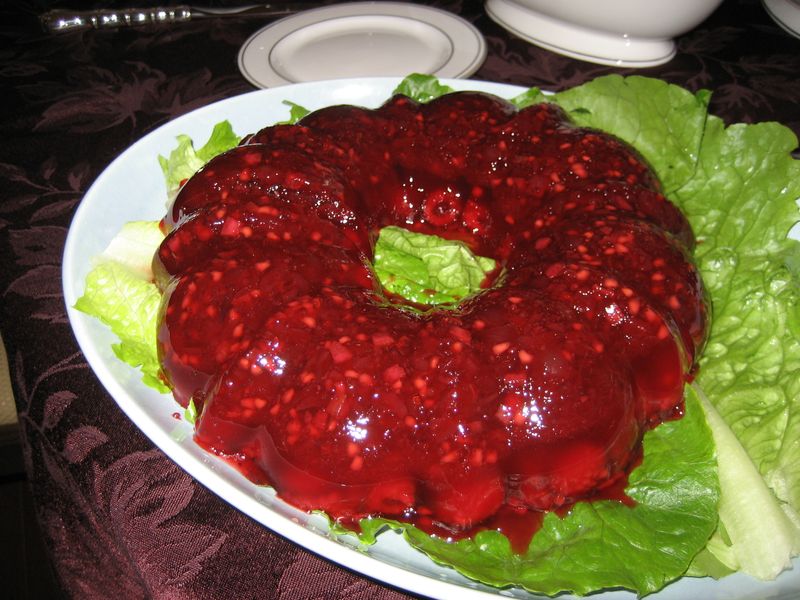
Jell-O salads, the crown jewel of church potlucks, were as colorful as they were wobbly. Picture a rainbow trapped in a gelatinous dome, with fruit pieces floating like dreams suspended in time. In those days, my aunt would proudly present her lime green concoction, always with a dollop of whipped cream on top.
These salads were a conversation starter, a culinary mystery that baffled both young and old. The tangy sweetness and the unexpected crunch of celery or nuts added to the thrill. It may not grace our tables today, but it remains a vivid memory of culinary creativity.
The Jell-O salad was more than a dish; it was a testament to the era’s experimental spirit, a sweet symbol of community gatherings.
2. Ambrosia

Ambrosia was the food of the gods—at least, that’s what we were told. This dish was a staple, a sweet, creamy concoction that brought smiles and sticky fingers. With its mix of marshmallows, coconut flakes, and canned fruit, it was a dessert and side dish rolled into one.
I remember the first time I tasted it; the unexpected combination of textures was both confusing and delightful. It was the kind of dish that made you wonder if its creator was a genius or just a bit eccentric.
Despite its oddity, Ambrosia held a cherished spot on many tables, its sweetness a reminder of the era’s penchant for mixing the unexpected.
3. Spam and Pineapple Skewers
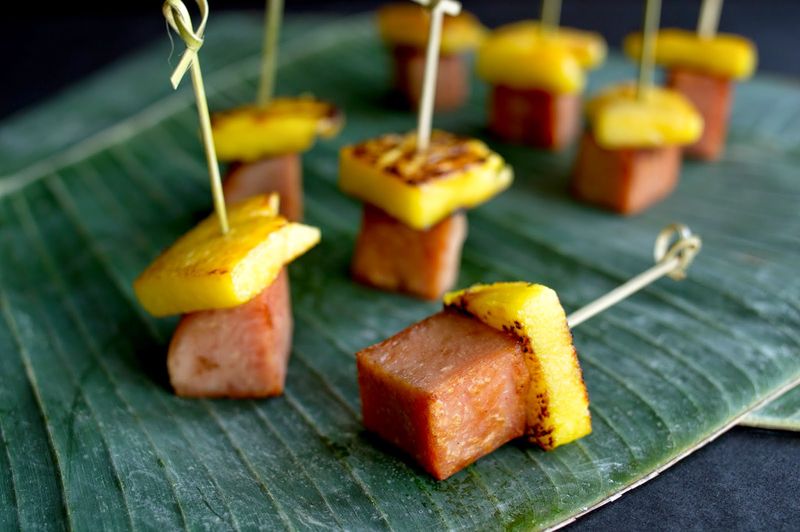
Spam was the meat of the future, and at our potlucks, it was celebrated in skewered form. Cubes of Spam alternated with chunks of pineapple, creating a sweet and salty masterpiece that was both intriguing and satisfying.
The skewers were a hit among those who appreciated Spam’s quirky charm and the tropical twist of pineapple. They were a testament to the era’s culinary creativity and resourcefulness.
These skewers were not just food; they were a conversation starter, a dish that invited curiosity and perhaps a raised eyebrow or two. They remind me of a time when experimentation was encouraged and taste was a journey.
4. 7-Up Cake
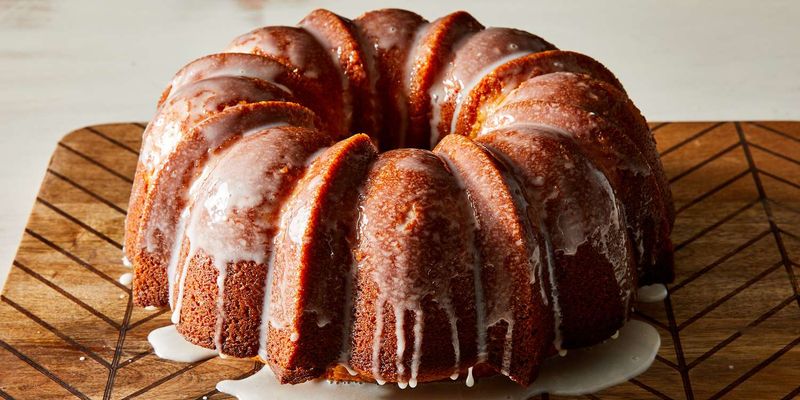
The 7-Up cake was a fizzy delight, a creation that bubbled with creativity. Made with the popular lemon-lime soda, this cake was moist and slightly tangy, a perfect balance of sweet and citrus.
I recall the first slice I ever had, its lightness and airy texture a revelation. It was a cake that seemed to defy gravity, much like the soda that inspired it.
This cake was more than just a dessert; it was a conversation piece, a sweet example of how resourcefulness turned pantry staples into something extraordinary.
5. Cheese and Pineapple Hedgehog

Imagine a hedgehog—a cheese and pineapple hedgehog, to be exact. This peculiar centerpiece was as much a visual delight as it was a gustatory one. Cubes of cheddar cheese and pineapple chunks were artfully arranged on a foil-covered potato, creating a whimsical and eye-catching display.
As a child, I found this creation both amusing and a bit perplexing. Why a hedgehog? Why cheese and pineapple? Yet, it was these questions that made it memorable and endearing.
This dish was a testament to the playful creativity of the era, reminding us that food was not just for eating, but also for entertaining both the eyes and the palate.
6. Aspic

Aspic was an adventure in gelatin, a savory counterpart to its sweeter cousins. This dish was a molded marvel, containing bits of meat and vegetables suspended in a clear, flavorful jelly.
I remember eyeing it with a mix of curiosity and caution, its shimmering surface hiding a treasure trove of textures and tastes. It was a dish that required both courage and a curious palate to appreciate.
While aspic might have faded from popularity, it remains a symbol of the era’s daring approach to culinary boundaries, a savory relic of a time when food was both art and adventure.
7. Cabbage Rolls
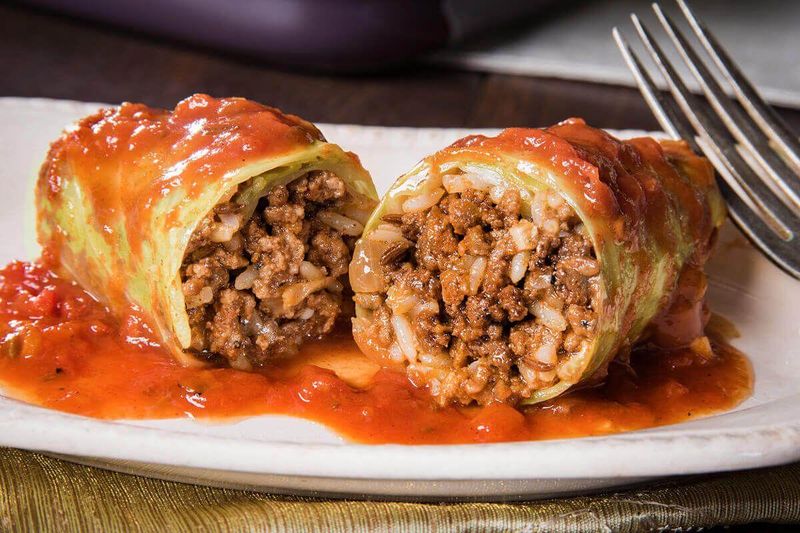
Cabbage rolls were the hearty heroes of the potluck table, a dish that promised warmth and satisfaction with every bite. Rolled in cabbage leaves, the filling of rice and seasoned meat was both comforting and flavorful.
I recall watching my grandmother expertly roll each leaf, her hands working with a speed that spoke of years of practice. Each roll was a compact package of love and tradition.
Though simple in appearance, cabbage rolls were a testament to the culinary wisdom passed down through generations, a dish that brought people together in both preparation and enjoyment.
8. Liver Pâté
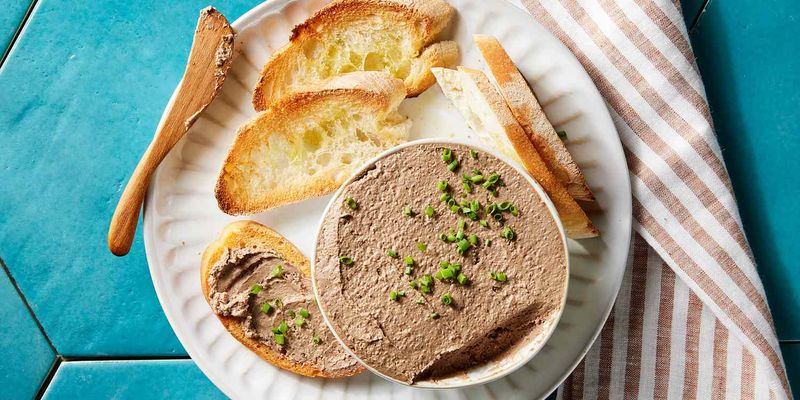
Liver pâté was the sophisticated side of potluck dining, a spread that promised a rich and indulgent experience. Made from finely blended liver and spices, it was smooth and flavorful.
As a child, I approached it with trepidation, unsure of its rich aroma and unfamiliar texture. Yet, for the adventurous eater, it was a delight, a spread that added a touch of elegance to any gathering.
Despite its acquired taste, liver pâté remains a curious reminder of the era’s penchant for gourmet experimentation, a savory spread that dared diners to expand their palates.
9. Watergate Salad
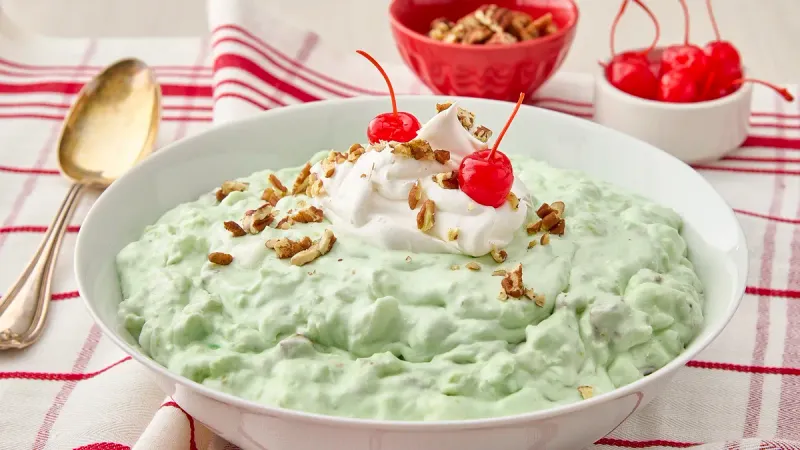
Watergate salad was a scandalously sweet creation, a dish that combined pistachio pudding with canned pineapple, marshmallows, and whipped topping. It was a green delight that brought a touch of whimsy to the table.
Named with a nod to the political scandal of the time, this salad was both intriguing and delicious. Its minty hue and fluffy texture made it a favorite among kids and adults alike.
A symbol of its era, Watergate salad was a playful dish that reminded us of the lighter side of life, a sweet escape amidst the savory offerings of a church potluck.
10. Perfection Salad
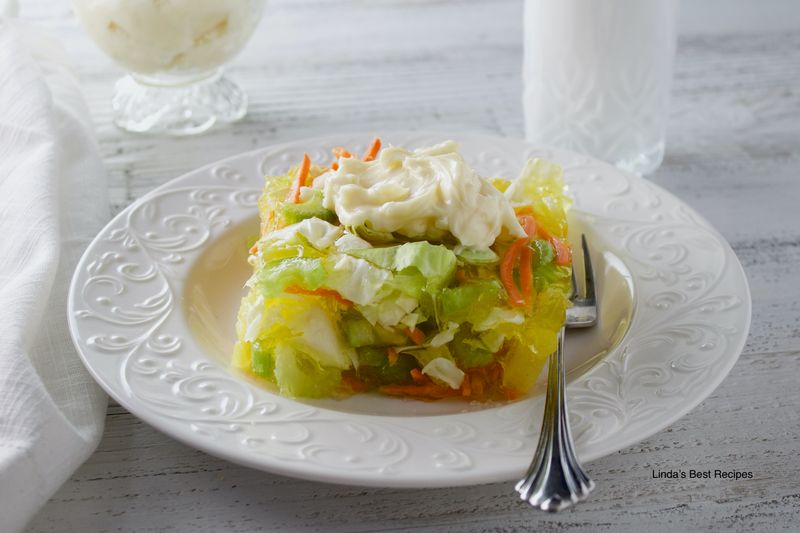
Perfection salad was an aspirational dish, a molded salad that showcased vegetables in a clear, tangy gelatin. It was a visual and textural experience, a dish that dared to be different.
I remember seeing it for the first time, its vibrant colors captured in a quivering embrace. It was both fascinating and a little intimidating, a dish that invited curiosity.
Though it might be an acquired taste, Perfection salad remains a tribute to the era’s innovative spirit, a reminder that the pursuit of culinary perfection was as much about presentation as it was about flavor.
11. Frog Eye Salad

Frog Eye salad was a curious name for a curious dish, a dessert that combined acini di pepe pasta with a creamy, fruity mix. Its unique texture and flavor made it both a puzzling and delightful experience.
I recall the first spoonful, the small pasta pearls adding a fun texture to the sweet blend of fruit and cream. It was a dish that invited both wonder and joy.
Despite its unusual name, Frog Eye salad was a testament to the playful creativity of church potlucks, a dessert that dared to be different and succeeded in delighting those who tried it.
12. Bologna Cake
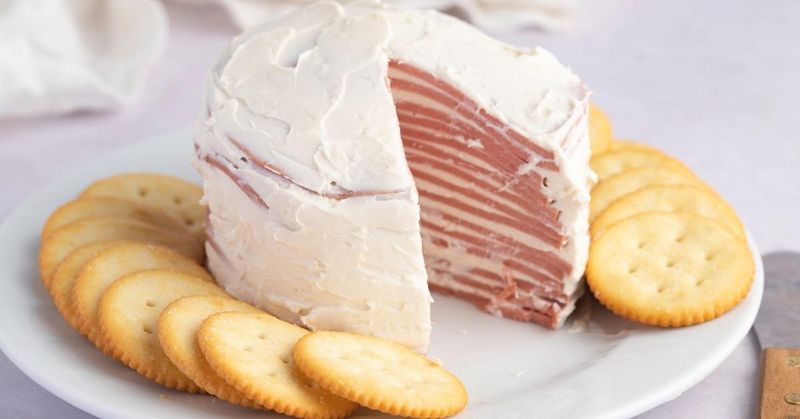
Bologna cake was the oddball of the potluck, a savory creation that turned heads and sparked conversations. Layers of bologna, alternated with cream cheese, created a “cake” that was both bizarre and intriguing.
I remember the first slice I saw, its pink layers adorned with olives, a sight that was both strange and fascinating. It was a dish that challenged perceptions and dared diners to take a leap of faith.
Though unconventional, bologna cake was a reflection of the era’s bold culinary experiments, a dish that celebrated the unexpected and left a lasting impression on all who encountered it.
13. Sauerkraut Surprise
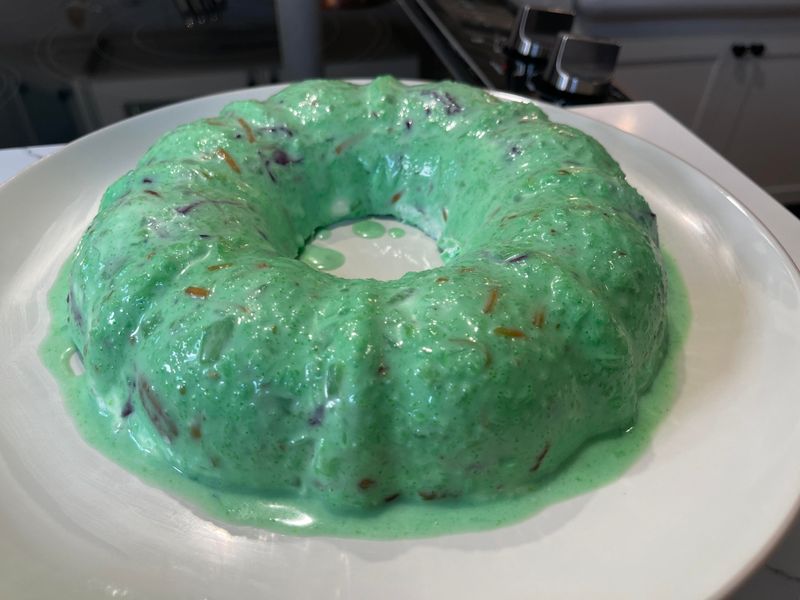
Sauerkraut Surprise was a dish that lived up to its name, a casserole that combined sauerkraut with unexpected ingredients like ground beef and noodles. It was a savory blend that dared to be different.
I remember the aroma filling the room, a tangy scent that promised something unique. The first bite was a revelation, a mix of textures and flavors that challenged expectations.
Though surprising, this dish was a reminder of the era’s willingness to experiment with bold flavors and create something memorable, a dish that left a lasting impression at any gathering.
14. Kool-Aid Pickles
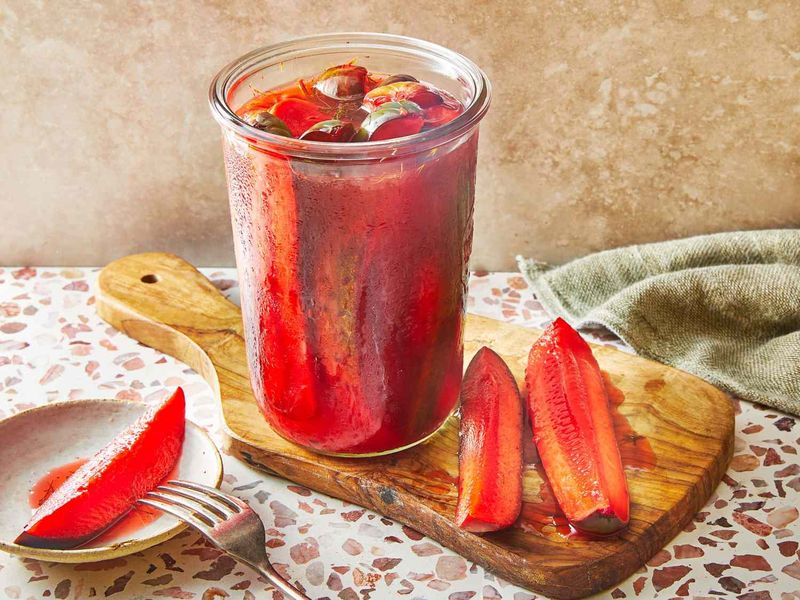
Kool-Aid pickles were a colorful curiosity, a snack that transformed ordinary pickles into a sweet and tangy treat. Soaked in Kool-Aid, these pickles took on a vibrant hue and a flavor that was both surprising and delightful.
I recall the first taste, a burst of sweet and sour that was both perplexing and enticing. It was a snack that defied logic and delighted the adventurous palate.
Though unusual, Kool-Aid pickles were a testament to the era’s playful approach to food, a reminder that sometimes the strangest combinations yield the most memorable results.
15. Pea Salad

Pea salad was a simple yet satisfying side, a dish that brought a touch of green to the potluck table. Made with peas, mayonnaise, and cheese, it was a creamy delight that promised comfort and flavor.
I remember scooping a spoonful onto my plate, its bright color and creamy texture inviting and delicious. It was a dish that brought joy to both young and old.
Though humble, pea salad was a testament to the era’s love of simple pleasures, a dish that celebrated the fresh flavors of the season and the joy of sharing food with others.
